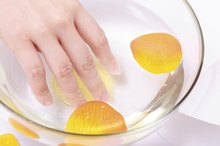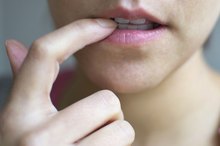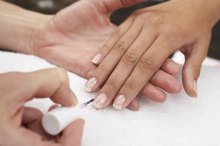What does fact checked mean?
At Healthfully, we strive to deliver objective content that is accurate and up-to-date. Our team periodically reviews articles in order to ensure content quality. The sources cited below consist of evidence from peer-reviewed journals, prominent medical organizations, academic associations, and government data.
- MayoClinic.com: Acrylic Nails: Can they Harm Natural Nails?
- U.S. Food & Drug Administration: How Nail Products are Regulated
The information contained on this site is for informational purposes only, and should not be used as a substitute for the advice of a professional health care provider. Please check with the appropriate physician regarding health questions and concerns. Although we strive to deliver accurate and up-to-date information, no guarantee to that effect is made.
Acrylic Nails & Toxins
Many women head to the salon for artificial nails for their convenience and beauty. The process requires a manicurist to apply artificial nail tips, using both a liquid and powder acrylic to bond the tips to your natural nails. Despite the attractiveness of acrylic nails, however, several toxins lurking in artificial nails can pose a risk to your health.
Process
Before acrylic nails can be applied, the manicurist cleans and files your natural nails 1. Once your nails are clean and dry, the manicurist selects artificial nail tips that match the width of your natural nails. She applies a liquid and powder acrylic, using a small brush to quickly blend the artificial nail tip and the natural nail. After the acrylic has been applied and the nail is bonded, the manicurist files your artificial nails to the desired length and buffs away any acrylic debris that may be left over.
- Before acrylic nails can be applied, the manicurist cleans and files your natural nails 1.
- After the acrylic has been applied and the nail is bonded, the manicurist files your artificial nails to the desired length and buffs away any acrylic debris that may be left over.
Chemicals
How to Stop Gnats From Swarming Your Head
Learn More
Toluene, a toxic chemical found in some nail polishes and acrylic nail glue, has been shown to cause:
- respiratory issues
- irritated skin
- headaches
- dizziness
Prolonged or repeated exposure to toluene may also pose more severe health problems, including damage to internal organs, such as the liver or kidneys.
Regulation
Both OSHA and the FDA monitor the use of toxic chemicals in nail salons, but it is ultimately the responsibility of each individual salon to inform their nail technicians about potential health risks and the proper way to handle these chemicals. Fortunately, OSHA's Hazard Communication Standard requires all product manufacturers to provide salon owners with a safety data sheet for all products that may contain dangerous chemicals. Additionally, this safety data sheet must also inform salon owners about the potential health risks associated with using the products; proper storage and usage tips; and a complete list of any hazardous chemicals in the products. The FDA also monitors the use of nail products in salons, and prohibits the use of any product that may contain harmful or dangerous chemicals that could pose a health hazard when used as directed.
- Both OSHA and the FDA monitor the use of toxic chemicals in nail salons, but it is ultimately the responsibility of each individual salon to inform their nail technicians about potential health risks and the proper way to handle these chemicals.
- Fortunately, OSHA's Hazard Communication Standard requires all product manufacturers to provide salon owners with a safety data sheet for all products that may contain dangerous chemicals.
Precautions
Cures for Acetone Damaged Nails
Learn More
Whether you are a frequent wearer of acrylic nails or only get them for special occasions, be aware of the potential risks to not only to your natural nails, but to your overall health as well. To avoid permanently damaging your natural nails, make sure to have your acrylics removed by a professional nail technician at a reputable salon. Additionally, make sure your technician properly sterilizes all tools and implements to avoid a potential infection. Finally, limit your exposure to toxic chemicals found in acrylic nails by wearing them infrequently. While short-term wear isn't likely to cause any permanent damage to your nails or your health, wearing acrylic nails regularly can pose a significant health risk.
- Whether you are a frequent wearer of acrylic nails or only get them for special occasions, be aware of the potential risks to not only to your natural nails, but to your overall health as well.
- Additionally, make sure your technician properly sterilizes all tools and implements to avoid a potential infection.
Related Articles
References
- MayoClinic.com: Acrylic Nails: Can they Harm Natural Nails?
- Occupational Health and Safety Administration: Health Hazards in Nail Salons
- New Jersey Department of Health & Senior Services: Hazardous Substance Fact Sheet
- Singal A, Arora R. Nail as a window of systemic diseases. Indian Dermatol Online J. 2015;6(2):67-74. doi:10.4103/2229-5178.153002
- Yaemsiri S, Hou N, Slining MM, He K. Growth rate of human fingernails and toenails in healthy American young adults. J Eur Acad Dermatol Venereol. 2010;24(4):420-3. doi:10.1111/j.1468-3083.2009.03426.x
- Schons KR, Knob CF, Murussi N, Beber AA, Neumaier W, Monticielo OA. Nail psoriasis: a review of the literature. An Bras Dermatol. 2014;89(2):312-7. doi:10.1590/abd1806-4841.20142633
- Abdullah L, Abbas O. Common nail changes and disorders in older people: Diagnosis and management. Can Fam Physician. 2011;57(2):173-81.
- Sarkar M, Mahesh DM, Madabhavi I. Digital clubbing. Lung India. 2012;29(4):354-62. doi:10.4103/0970-2113.102824
- Haneke E. Controversies in the treatment of ingrown nails. Dermatol Res Pract. 2012;2012:783924. doi:10.1155/2012/783924
- Jefferson J, Rich P. Melanonychia. Dermatol Res Pract. 2012;2012:952186. doi:10.1155/2012/952186
- Aging Changes in Hair and Nails. Medline. National Institutes of Health Public Information Sheet.
- Nails and Nail Problems. American Academy of Dermatology Public Information Sheet.
Writer Bio
Denise Shively has been writing professionally for more than nine years. Her publication credits include The Fashionable Housewife, Blushing Bridezilla and many more. She has also written for many private clients and specializes in women's-oriented topics.









